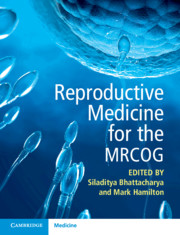Book contents
- Reproductive Medicine for the MRCOG
- Reproductive Medicine for the MRCOG
- Copyright page
- Contents
- Contributors
- Chapter 1 Epidemiology and Initial Assessment of the Infertile Patient
- Chapter 2 Disorders of Ovulation and Reproductive Endocrine Disorders Associated with Infertility
- Chapter 3 Endometriosis
- Chapter 4 Uterine and Tubal Causes of Infertility
- Chapter 5 Andrology and Infertility
- Chapter 6 Unexplained Infertility
- Chapter 7 Assisted Reproduction
- Chapter 8 Adjuvants in Assisted Reproduction
- Chapter 9 Laboratory Procedures for Assisted Reproduction
- Chapter 10 Fertility Preservation
- Chapter 11 Third-Party Reproduction
- Chapter 12 Managing Ethical Dilemmas in Reproductive Medicine
- Chapter 13 Evidence-Based Reproductive Medicine
- Chapter 14 The Organisation of Services and Quality Assurance in Fertility Practice
- Index
- References
Chapter 8 - Adjuvants in Assisted Reproduction
Published online by Cambridge University Press: 25 February 2021
- Reproductive Medicine for the MRCOG
- Reproductive Medicine for the MRCOG
- Copyright page
- Contents
- Contributors
- Chapter 1 Epidemiology and Initial Assessment of the Infertile Patient
- Chapter 2 Disorders of Ovulation and Reproductive Endocrine Disorders Associated with Infertility
- Chapter 3 Endometriosis
- Chapter 4 Uterine and Tubal Causes of Infertility
- Chapter 5 Andrology and Infertility
- Chapter 6 Unexplained Infertility
- Chapter 7 Assisted Reproduction
- Chapter 8 Adjuvants in Assisted Reproduction
- Chapter 9 Laboratory Procedures for Assisted Reproduction
- Chapter 10 Fertility Preservation
- Chapter 11 Third-Party Reproduction
- Chapter 12 Managing Ethical Dilemmas in Reproductive Medicine
- Chapter 13 Evidence-Based Reproductive Medicine
- Chapter 14 The Organisation of Services and Quality Assurance in Fertility Practice
- Index
- References
Summary
In this chapter, the evidence and use of in vitro fertilisation (IVF) add-ons in the UK is explored. In addition, the stance of professional and regulatory bodies is described. The term ‘add-on’ has been coined to describe the additional ‘extras’ to a routine or intracytoplasmic sperm injection cycle that are commonly offered to those undergoing treatment with the aim of improving livebirth rates. A summary of the highest quality available evidence for the following add-ons is presented: endometrial scratching; time-lapse imaging; assisted hatching; preimplantation genetic testing (PGT-A); endometrial receptivity array; GM-CSF containing culture media; Embryo Glue (hyaluronic acid); artificial egg activation with calcium ionophore; intracytoplasmic morphologically selected sperm injection (IMSI); physiological intracytoplasmic sperm injection (PICSI); sperm DNA test; and reproductive immunology procedures. There remains a paucity of evidence to support the routine use of add-ons based on the available randomised controlled trial and systematic review evidence. This is particularly important given that most patients pay additional fees to utilise add-ons. In order for patients to receive high- quality care in IVF clinics, clinicians must be prepared to discuss the relevant evidence regarding efficacy and safety of the specific add-on being considered.
Keywords
- Type
- Chapter
- Information
- Reproductive Medicine for the MRCOG , pp. 82 - 92Publisher: Cambridge University PressPrint publication year: 2021

